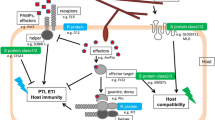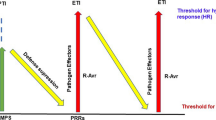Abstract
Resistant germplasm resources are valuable for developing resistant varieties in agricultural production. However, recessive resistance genes are usually overlooked in hybrid breeding. Compared with dominant traits, however, they may confer resistance to different pathogenic races or pest biotypes with different mechanisms of action. The recessive rice bacterial blight resistance gene xa13, also involved in pollen development, has been cloned and its resistance mechanism has been recently characterized. This report describes the conversion of bacterial blight resistance mediated by the recessive xa13 gene into a dominant trait to facilitate its use in a breeding program. This was achieved by knockdown of the corresponding dominant allele Xa13 in transgenic rice using recently developed artificial microRNA technology. Tissue-specific promoters were used to exclude most of the expression of artificial microRNA in the anther to ensure that Xa13 functioned normally during pollen development. A battery of highly bacterial blight resistant transgenic plants with normal seed setting rates were acquired, indicating that highly specific gene silencing had been achieved. Our success with xa13 provides a paradigm that can be adapted to other recessive resistance genes.





Similar content being viewed by others
References
Brauer EK, Rochona A, Bib YM, Bozzoa GG, Rothsteinb SJ, Shelpa BJ (2011) Reappraisal of nitrogen use efficiency in rice overexpressing glutamine synthetase1. Physiol Plantarum 141:361–372
Chen C, Ridzon DA, Broomer AJ, Zhou Z, Lee DH, Nguyen JT, Barbisin M, Xu NL, Mahuvakar VR, Andersen MR, Lao KQ, Livak KJ, Guegler KJ (2005) Real-time quantification of microRNAs by stem-loop RT-PCR. Nucleic Acids Res 33:e179
Chen L, Hou B, Lalonde S, Takanaga H, Hartung ML, Qu X, Guo W, Kim J, Underwood W, Chaudhuri B, Chermak D, Antony G, White FF, Somerville SC, Mudgett MB, Frommer WB (2010) Sugar transporters for intercellular exchange and nutrition of pathogens. Nature 468:527–532
Chu Z, Yuan M, Yao J, Ge X, Yuan B, Xu C, Li X, Fu B, Li Z, Bennetzen JL, Zhang Q, Wang S (2006) Promoter mutations of an essential gene for pollen development result in disease resistance in rice. Genes Dev 20:1250–1255
Davuluri GR, Van Tuinen A, Fraser PD, Manfredonia A, Newman R, Burgess D, Brummell DA, King SR, Palys J, Uhlig J, Bramley PM, Pennings HMJ, Bowler C (2005) Fruit-specific RNAi-mediated suppression of DET1 enhances carotenoid and flavonoid content in tomatoes. Nat Biotechnol 23:890–895
Fukuoka S, Saka N, Koga H, Ono K, Shimizu T, Ebana K, Hayashi N, Takahashi A, Hirochika H, Okuno K, Yano M (2009) Loss of function of a proline-containing protein confers durable disease resistance in rice. Science 325:998–1001
Ganesan S, LeAnne MC, Lorraine P, Stipanovic RD, Rathore KS (2006) Engineering cottonseed for use in human nutrition by tissue-specific reduction of toxic gossypol. Proc Natl Acad Sci USA 103:18054–18059
Garneau NL, Wilusz J, Wilusz CJ (2007) The highways and byways of mRNA decay. Natl Rev Mol Cell Biol 8:113–126
Huang HQ, Lin YJ (2007) Cloning and functional analysis of the rice rbcS gene promoter. J Agr Biotechnol 15:451–458
Huang S, Frizzi A, Florida CA, Kruger DE, Luethy MH (2006) High lysine and high tryptophan transgenic maize resulting from the reduction of both 19- and 22-kD α-zeins. Plant Mol Biol 61:525–535
Jorgensen K, Bak S, Busk PK, Sorensen C, Olsen CE, Puonti-Kaerlas J, Moller BL (2005) Cassava plants with a depleted cyanogenic glucoside content in leaves and tubers. Distribution of cyanogenic glucosides, their site of synthesis and transport, and blockage of the biosynthesis by RNA interference technology. Plant Physiol 139:363–374
Kauffman HE, Reddy APK, Hsieh SPY, Merca SD (1973) An improved technique for evaluating resistance to rice varieties of Xanthomonas oryzae. Plant Dis Rep 57:537–541
Khraiwesh B, Ossowski S, Weigel D, Reski R, Frank W (2008) Specific gene silencing by artificial microRNAs in Physcomitrella patens: an alternative to targeted gene knockouts. Plant Physiol 148:684–693
Kyozuka J, McElroy D, Hayakawa T, Xie Y, Wu R, Shimamoto K (1993) Light-regulated and cell-specific expression of tomato rbcS-gusA and rice rbcS-gusA fusion genes in transgenic rice. Plant Physiol 102:991–1000
Li ZK, Sanchez A, Angeles E, Singh S, Domingo J, Huang N, Khush GS (2001) Are the dominant and recessive plant disease resistance genes similar? A case study of rice R genes and Xanthomonas oryzae pv. oryzae races. Genetics 159:757–765
Lin YJ, Zhang Q (2005) Optimizing the tissue culture conditions for high efficiency transformation of indica rice. Plant Cell Rep 23:540–547
Liu KD, Wang J, Li HB, Xu CG, Zhang Q (1997) A genome-wide analysis of wide-compatibility in rice and the precise location of the S5 locus in the molecular map. Theor Appl Genet 95:809–814
Liu Q, Singh SP, Green AG (2002) High-stearic and high-oleic cottonseed oils produced by hairpin RNA-mediated post-transcriptional gene silencing. Plant Physiol 129:1732–1743
Mew TW, Vera Cruz CM, Medalla ES (1992) Changes in race frequency of Xanthomonas oryzae pv. oryzae in response to rice cultivars planted in the Philippines. Plant Dis 76:1029–1032
Molnar A, Bassett A, Thuenemann E, Schwach F, Karkare S, Ossowski S, Weigel D, Baulcombe D (2008) Highly specific gene silencing by artificial microRNAs in the unicellular alga Chlamydomonas reinhardtii. Plant J 58:165–174
Nomura M, Katayama K, Nishimura A, Ishida Y, Ohta S, Komari T, Miyao-Tokutomi M, Tajima S, Matsuoka M (2000) The promoter of rbcS in a C3 plant (rice) directs organ-specific, light-dependent expression in a C4 plant (maize), but does not confer bundle sheath cell-specific expression. Plant Mol Biol 44:99–106
Ossowski S, Schwab R, Weigel D (2008) Gene silencing in plants using artificial microRNAs and other small RNAs. Plant J 53:674–690
Peng Q, Hu Y, Wei R, Zhang Y, Guan C (2010) Simultaneous silencing of FAD2 and FAE1 genes affects both oleic acid and erucic acid contents in Brassica napus seeds. Plant Cell Rep 29:317–325
Regina A, Bird A, Topping D, Bowden S, Freeman J, Barsby T, Kosar-Hashemi B, Li Z, Rahman S, Morell M (2006) High-amylose wheat generated by RNA interference improves indices of large-bowel health in rats. Proc Natl Acad Sci USA 103:3546–3551
Reuter JS, Mathews DH (2010) RNAstructure: software for RNA secondary structure prediction and analysis. BMC Bioinform 11:129
Sasaki A, Ashikari M, Ueguchi-Tanaka M, Itoh H, Nishimura A, Swapan D, Ishiyama K, Saito T, Kobayashi M, Khush GS, Kitano H, Matsuoka M (2002) Green revolution: a mutant gibberellin-synthesis gene in rice. Nature 416:701–702
Schaffner AR, Scheen J (1991) Maize rbcS promoter activity depends on sequence elements not found in dicot rbcS promoters. Plant Cell 3:997–1012
Schwab R, Ossowski S, Riester M, Warthmann N, Weigel D (2006) Highly specific gene silencing by artificial microRNAs in Arabidopsis. Plant Cell 18:1121–1133
Shen J, Xie K, Xiong L (2010) Global expression profiling of rice microRNAs by one-tube stem-loop reverse transcription quantitative PCR revealed important roles of microRNAs in abiotic stress responses. Mol Genet Genomics 284:477–488
Spielmeyer W, Ellis MH, Chandler PM (2002) Semidwarf (sd-1), “green revolution” rice, contains a defective gibberellin 20-oxidase gene. Proc Natl Acad Sci USA 99:9043–9048
Sun X, Cao Y, Yang Z, Xu C, Li X, Wang S, Zhang Q (2004) Xa26, a gene conferring resistance to Xanthomonas oryzae pv. oryzae in rice, encodes an LRR receptor kinase-like protein. Plant J 37:517–527
Tang W, Chen H, Xu CG, Li XH, Lin YJ, Zhang QF (2006) Development of insect-resistant transgenic indica rice with a synthetic cry1C* gene. Mol Breed 18:1–10
Warthmann N, Chen H, Ossowski S, Weigel D, Hervé P (2008) Highly specific gene silencing by artificial miRNAs in rice. PLoS One 3(3):e1829
Xie K, Wu C, Xiong L (2006) Genomic organization, differential expression and interaction of SPL transcription factors and microRNA156 in rice. Plant Physiol 142:280–293
Xing S, Zachgo S (2007) Pollen lethality: a phenomenon in Arabidopsis RNA interference plants. Plant Physiol 145:330–333
Xiong A, Yao Q, Peng R, Li X, Han P (2005) Different effects on ACC oxidase gene silencing triggered by RNA interference in transgenic tomato. Plant Cell Rep 23:639–646
Xu P, Zhang Y, Kang L, Roossinck MJ, Mysore KS (2006) Computational estimation and experimental verification of off target silencing during posttranscriptional gene silencing in plants. Plant Physiol 142:429–440
Yang B, Sugio A, White FF (2006) Os8N3 is a host disease-susceptibility gene for bacterial blight of rice. Proc Natl Acad Sci USA 103:10503–10508
Ye R, Huang H, Yang Z, Chen T, Liu L, Li X, Chen H, Lin Y (2009) Development of insect-resistant transgenic rice with Cry1C*-free endosperm. Pest Manag Sci 65:1015–1020
Yuan M, Chu Z, Li X, Xu C, Wang S (2009) Pathogen-induced expressional loss of function is the key factor in race-specific bacterial resistance conferred by a recessive R gene xa13 in rice. Plant Cell Physiol 50:947–955
Yuan M, Chu Z, Li X, Xu C, Wang S (2010) The bacterial pathogen Xanthomonas oryzae overcomes rice defenses by regulating host copper redistribution. Plant Cell 22:3164–3176
Zhang Q (2009) Genetics and improvement of resistance to bacterial blight in hybrid rice in China. Chin J Rice Sci 23:111–119
Acknowledgments
We thank Professor Shiping Wang for providing Xoo strain PXO99 and Professor Detlef Weigel for providing the pNW55 plasmid. This research was supported by National Special Key Project for Transgenic Breeding (2008ZX08010-002-1) and International Foundation for Science.
Author information
Authors and Affiliations
Corresponding author
Additional information
Communicated by P. Ozias-Akins.
Electronic supplementary material
Below is the link to the electronic supplementary material.
Fig. S1 Schematic diagram of transfer DNA regions of the four final expression vectors. a Osrbcp-amiA; b Atrbcsp-amiA; c Osrbcp-amiB; d Atrbcp-amiB.
Fig. S2 Relative expression of Xa13 in the leaves of transgenic plants by qRT-PCR using Oligo(dT)18 and random hexamer primers. The relative quantity of Xa13 mRNA in the lines expressing amiA detected using random hexamer primers is higher than that using Oligo(dT)18 primer, but no similar phenomenon was observed in lines expressing amiB. Wt, Wild type.
Rights and permissions
About this article
Cite this article
Li, C., Wei, J., Lin, Y. et al. Gene silencing using the recessive rice bacterial blight resistance gene xa13 as a new paradigm in plant breeding. Plant Cell Rep 31, 851–862 (2012). https://doi.org/10.1007/s00299-011-1206-8
Received:
Revised:
Accepted:
Published:
Issue Date:
DOI: https://doi.org/10.1007/s00299-011-1206-8




